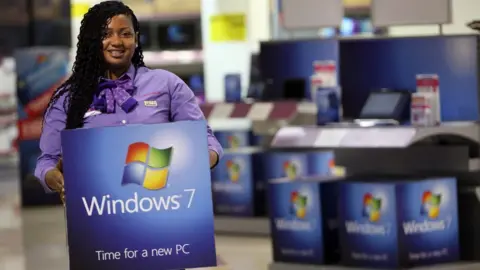Microsoft ends Windows 7 support: What should you do?
 Oli Scarff
Oli ScarffCyber-security experts are urging Windows 7 users to upgrade their operating system.
Microsoft is going to stop supporting Windows 7 from Tuesday so that it can focus on "newer technologies".
As a result, Windows 7 users will no longer receive the all-important security updates and patches that keep their machines safe.
One in four Windows users is running Windows 7, according to statistics website StatCounter.
What does this all mean?
It means that Microsoft is ending the cat-and-mouse game with hackers seeking to exploit software bugs in the Windows 7 operating system.
If perpetrators find a flaw in Windows 7, Microsoft will not fix it.
Without continued software and security updates, Windows 7 machines are more likely to be infected with viruses and malware, Microsoft wrote on its website.
"Running an unpatched machine means that the flaws in the code will never be fixed and as exploits for those flaws become known and widespread, your chances of being successfully attacked grow very rapidly," said Rik Ferguson, vice-president of security research at Trend Micro.
David Emm, a senior security researcher at Kaspersky Lab, added that people need to move to a supported operating system as soon as possible.
What are the risks?
Hackers use malware to invade, damage or disable computers.
It can be used to steal personal and financial data, spy on other users without them knowing, and to hold companies to ransom until a payment is made.
In May 2017, the NHS was hit by the WannaCry ransomware attack.
A government report in 2018 concluded that the attack could have been avoided if NHS Trusts had updated their computers and applied the necessary security patches.
Hackers exploited weaknesses in unpatched versions of Windows 7, as well as to a lesser extent the earlier Windows XP, which Microsoft had stopped supporting.
What should you do with your Windows 7 PC?
Computers running Windows 7 will still function after Tuesday but they will become less and less secure.
Microsoft is urging people to move to Windows 10, a newer operating system that it sells for £120.
"Going forward, the best way for you to stay secure is on Windows 10," it said. "And the best way to experience Windows 10 is on a new PC."
It is possible to install Windows 10 on old PCs but Microsoft warns that it may not run smoothly.
In order to run Windows 10, PCs must have a 1GHz processor, 16GB of hard drive space, and 1GB of RAM memory.
"While it is possible to install Windows 10 on your older device, it is not recommended," Microsoft said.
That said, Windows 7 users do not need to upgrade if they use their PC offline.
What do UK officials say?
UK authorities have warned Windows 7 users not to do internet banking or send emails after Tuesday.
The warning was issued by the National Cyber Security Centre, which is part of Britain's intelligence agency GCHQ, and first reported by The Telegraph,.
"We would urge those using the software after the deadline to replace unsupported devices as soon as possible, to move sensitive data to a supported device and not to use them for tasks like accessing bank and other sensitive accounts," an NCSC spokesperson told the BBC.
"They should also consider accessing email from a different device."
What about for businesses?
Some companies rely heavily on applications that only work with Windows 7.
Businesses can pay Microsoft if they want to continue getting updates for Windows 7 Professional or Windows 7 Enterprise.
The Windows 7 Extended Security Updates will be available until 2023 for businesses of all sizes.
Charges range from $25 (£19) per device to $200 per device and increase each year. The costs will mount quickly for organisations with lots of computers.
For businesses, it is not always easy to upgrade to a newer operating system, Mr Ferguson said.
"There may be business-critical applications that will not run on newer operating systems, or there may be significant costs associated with upgrading those applications," he said.
Places like hospitals and factories may have equipment that is designed to run exclusively on Windows 7.
"The user is not always able to upgrade without voiding the warranty," said Mr Ferguson.
